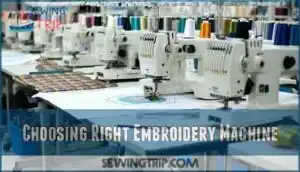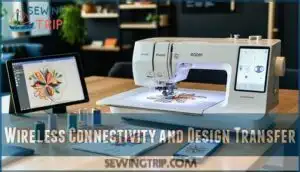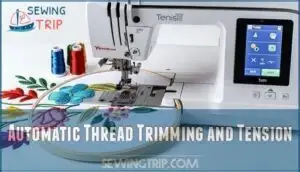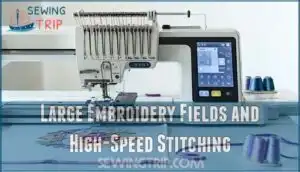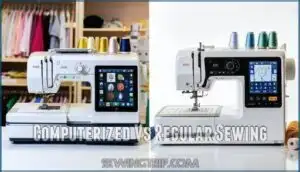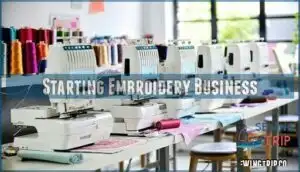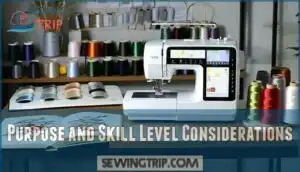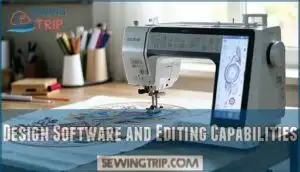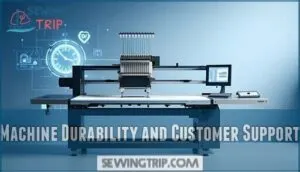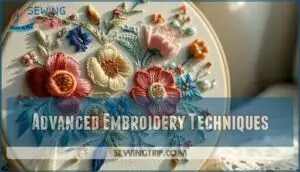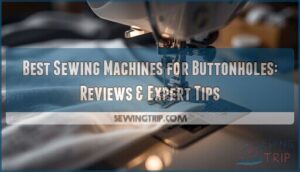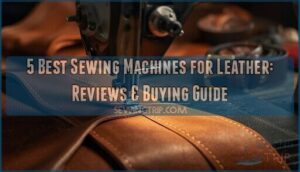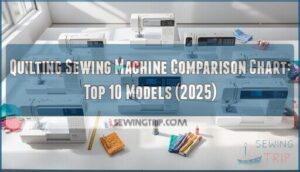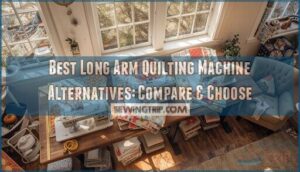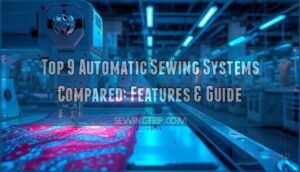This site is supported by our readers. We may earn a commission, at no cost to you, if you purchase through links.
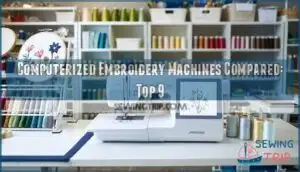
Top contenders like the Brother SE1900 and Janome Memory Craft 500E deliver professional results whether you’re a weekend crafter or running a small business.
These machines handle everything from monogramming to complex multi-color designs with push-button ease.
Consider your hoop size needs, built-in design library, and whether you want combination sewing capabilities.
The right machine transforms your creative vision into stunning embroidered reality.
Understanding specific features and comparing performance metrics reveals which machine truly fits your crafting goals.
Table Of Contents
- Key Takeaways
- Computerized Embroidery Basics
- Choosing Right Embroidery Machine
- Top 9 Computerized Machines
- 1. Brother Embroidery Machine Hoops Sew Tech
- 2. Brother PE900 WLAN Embroidery Machine White
- 3. Brother Inno Vis Embroidery Machine
- 4. Brother Wireless Embroidery Machine System
- 5. Sewing and Embroidery Machine Sparrow
- 6. Brother Sewing and Embroidery Machine
- 7. Brother computerized sewing embroidery machine
- 8. Janome embroidery machine for sewing
- 9. Commercial Embroidery Machine Smartstitch S1501
- Embroidery Machine Features
- Computerized Vs Regular Sewing
- Starting Embroidery Business
- Selecting Best Embroidery Machine
- Advanced Embroidery Techniques
- Frequently Asked Questions (FAQs)
- Conclusion
Key Takeaways
- You’ll want to consider the embroidery field size, built-in designs, and wireless connectivity when choosing a computerized embroidery machine that fits your needs, so you can create stunning embroidery designs with ease.
- Computerized embroidery machines offer advanced features like automatic thread trimming, design editing software, and high-speed stitching, which can enhance your sewing and embroidery experience, and you’ll need to evaluate these features based on your skill level and project requirements.
- When selecting a machine, you should think about your budget, the type of projects you’ll be working on, and the level of complexity you’re comfortable with, so you can pick a machine that’s user-friendly and meets your creative demands.
- You’ll also need to research the machine’s durability, customer support, and maintenance requirements, as these factors can impact your overall experience and the quality of your embroidery work, and you should look for machines with good warranties, reliable customer service, and easy troubleshooting options.
Computerized Embroidery Basics
You’re about to learn the basics of computerized embroidery machines, which are essential for creating custom designs.
As you read on, you’ll understand what computerized embroidery machines are, how they work, and their benefits, helping you make an informed decision when choosing the right machine for your needs.
What is a Computerized Embroidery Machine
You’re exploring computerized embroidery machines, which use embroidery software and digital controls to create automatic, computerized stitches.
These machines offer various types, including wireless embroidery machines, and often feature automatic functions, making them a great tool for embroidery enthusiasts and professionals alike, with computer embroidery capabilities.
Understanding computerized sewing machines is essential for selecting the right equipment for your projects.
How Computerized Embroidery Machines Work
Computerized embroidery machines work by reading digital embroidery files that contain encoded stitch patterns and thread control instructions.
Digital designs become automatic stitches through computerized precision and control.
The Computer Interface translates these files into precise needle movements and Thread Control commands.
Here’s how embroidery machine technology operates:
- Digital File Processing – Embroidery software converts designs into machine-readable formats
- Machine Mechanics – Motors control needle positioning and fabric movement
- Automatic Needle Threader – Reduces manual threading time between color changes
- Stitch Patterns – Pre-programmed sequences create consistent, repeatable designs
- Embroidery Speed – Computer-controlled timing guarantees quality at various speeds
Wireless embroidery machines can receive files directly from tablets or phones, eliminating USB transfers.
Benefits of Computerized Embroidery Machines
You’ll discover computerized embroidery machines offer increased efficiency through automated processes that eliminate manual threading and pattern adjustments.
Automated precision beats manual effort every time in modern embroidery.
These machines deliver improved accuracy** with precise stitch placement, while enhanced designs become possible through built-in patterns and editing capabilities.
Faster production speeds up to 1200 stitches per minute boost your output substantially compared to traditional methods, allowing for increased efficiency.
Choosing Right Embroidery Machine
Selecting the right embroidery machine depends on matching your specific needs with the machine’s capabilities.
You’ll want to examine three key factors: function and purpose, hoop size and built-in designs, and price with warranty considerations.
Function and Purpose
First, decide whether you need embroidery-only or combo sewing machines.
Machine Types vary substantially in their Design Capabilities and Stitch Functions.
Embroidery-only computerized embroidery machines excel at detailed decorative work, while combo units handle both tasks efficiently.
Consider your primary Embroidery Uses – custom apparel, home décor, or commercial projects.
Operational Modes differ between machine categories, affecting embroidery machine purpose and workflow efficiency for your specific needs.
When selecting a machine, understanding embroidery machine options is vital for making an informed decision.
Hoop Size and Built-in Designs
Once you know what you want to make, hoop size and built-in designs become the backbone of your search.
Larger hoops mean big, bold patterns—think family reunion shirts or giant logos.
Embroidery machine features like built-in designs boost your design capacity.
Always check machine specs for embroidery fields and stitch limits, so your embroidery patterns don’t get cut short.
Understanding the correct hoop size options is essential for achieving the desired embroidery results.
Price and Warranty Considerations
When weighing embroidery machine price, compare features for real embroidery machine value.
Look at warranty options and ask about embroidery machine warranty coverage—it’s no use crying over spilled thread months later.
Check for discount availability and see how your pick stacks up in a cost comparison.
Good budget planning and careful price analysis lead to better embroidery machine cost-effectiveness.
Top 9 Computerized Machines
You’re about to see the top nine computerized embroidery machines that can make designs look almost effortless.
Whether you want fast stitching, easy pattern transfer, or just a machine that won’t quit after one thread jam, these models stand out for their smart features and reliability.
1. Brother Embroidery Machine Hoops Sew Tech
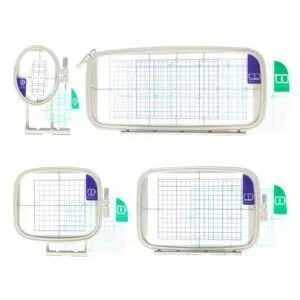
A solid set of Brother embroidery machine hoops from Sew Tech always makes projects easier.
These hoops fit a wide range of Brother models, plus some Baby Lock and Janome machines, cutting down on design transfer headaches.
Clear markings and sturdy construction mean you won’t be second guessing your alignment mid-project.
If you like working on a variety of sizes or split designs, having extra hoops saves time.
Their compatibility and durability make them a smart choice for anyone serious about embroidery, whether you’re just starting or leveling up.
They are a smart investment for those who want to work efficiently and effectively with their embroidery machine, making them a smart choice.
Best For: Anyone using Brother, Baby Lock, or Janome embroidery machines and looking for durable, reliable hoops that fit a wide range of models.
- Some users experience a tight fit or initial difficulty inserting hoops into certain machines.
- Compatibility with specific models like Brother SE2000 may be unclear from packaging.
- Made entirely of plastic, which may not appeal to those preferring metal accessories.
- Compatible with multiple machine brands and models, streamlining project setup.
- Strong, rigid construction and clear markings make alignment easy and precise.
- Having extra hoops on hand speeds up embroidery projects and allows for multitasking.
2. Brother PE900 WLAN Embroidery Machine White
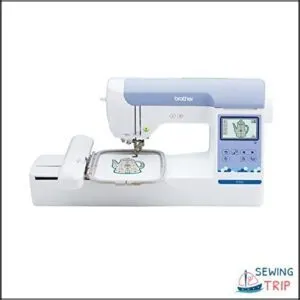
The Brother PE900 WLAN punches above its weight if you want embroidery only, not sewing.
You get a roomy 5" x 7" field and 193 built-in designs, so your creativity won’t hit a wall.
Editing is a breeze with the color touchscreen, while wireless LAN means no tangled cords—just send designs straight from your computer or phone.
Throw in features like automatic thread trimming, on-screen tutorials, and lifetime tech support, and you’ve got a user-friendly, precision tool for home embroidery projects.
Best For: Home crafters and hobbyists who want an easy-to-use embroidery-only machine with wireless design transfer and strong creative features.
- Large 5" x 7" embroidery area for bigger designs
- Wireless LAN for quick, cable-free design transfers
- Beginner-friendly touchscreen and built-in tutorials
- Not a traditional sewing machine—embroidery only
- Requires firmware updates and USB drive (not included) for full features
- Occasional quality control issues and limited repair centers
3. Brother Inno Vis Embroidery Machine
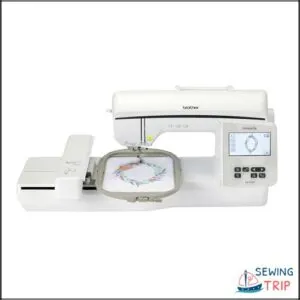
A versatile choice in embroidery, the Inno-vis series stands out for its user-friendly design and advanced features.
You’ll find 258 built-in designs, plenty of frame pattern options, and wireless connectivity—so you don’t have to fumble with USB drives.
The ample 6" x 10" embroidery area lets you tackle larger projects with fewer hoop changes.
Whether you’re just getting started or trying to up your embroidery game, this machine’s intuitive touchscreen and portability help keep creative block at bay, making it a great choice for those who value user-friendly design and advanced features.
Best For: beginners and experienced embroiderers who value user-friendly design and advanced features.
- The machine has a large 6" x 10" embroidery area for tackling larger projects with fewer hoop changes.
- It features wireless connectivity, allowing for easy design transfer without the need for USB drives.
- The intuitive touchscreen and portability of the machine make it a great choice for those who want to stay creative.
- Some users have reported issues with the hoop sensor and file reading.
- There have been mixed reviews on the machine’s reliability and repair experiences.
- Software issues have been reported with some units, which can be frustrating for users.
4. Brother Wireless Embroidery Machine System
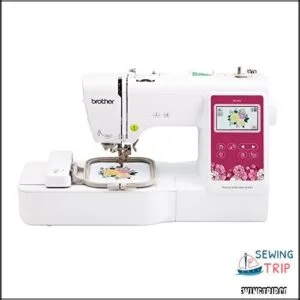
You’re considering the Brother Wireless Embroidery Machine System. Several models offer wireless connectivity, enabling seamless design transfers.
The Brother SE700, for instance, features a 4" x 4" embroidery field and 135 built-in designs. It connects to the Artspira app, allowing custom design creation and wireless transfer, making it a great option for those seeking convenience and creativity.
The machine’s advanced features, including computerized sewing, make it an ideal choice for sewists who want to explore various stitching options and techniques, with a focus on convenience and creativity.
Best For: beginners or hobbyists who want a user-friendly embroidery machine with wireless connectivity and a variety of built-in designs.
- The embroidery field is limited to 4" x 4", which may not be suitable for large or complex projects.
- Some users have experienced technical issues with thread tension and software compatibility.
- The machine is not ideal for business use due to its small embroidery area and limited functionality.
- The machine features a large 3.7" color touchscreen for easy design editing and preview.
- It has a wireless LAN connectivity that allows seamless design transfers via the Artspira mobile app.
- The machine comes with 135 built-in designs, 10 fonts, and a generous 25-year limited warranty.
5. Sewing and Embroidery Machine Sparrow
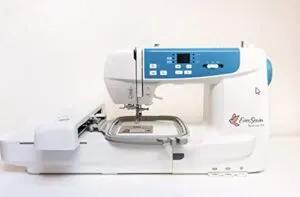
You’re looking at the Sewing and Embroidery Machine Sparrow, a combo machine with 120 built-in stitch patterns.
It features wireless connectivity, thread cutter, and one-step buttonhole.
This machine is priced at $849.99 with free shipping, making it a competitive option.
It’s suitable for beginners and advanced sewists, offering ease of use and innovative features for unique projects.
Best For: beginners and advanced sewists looking for a combo sewing and embroidery machine with innovative features and ease of use.
- Offers 120 built-in stitch patterns and wireless connectivity for unique projects
- Features thread cutter, one-step buttonhole, and other advanced functions for efficient sewing
- Priced at $849.99 with free shipping, making it a competitive option in the market
- Has a learning curve, with some users finding it challenging to set up and use
- Some users have reported issues with needle threader, poorly digitized designs, and connectivity problems
- Limited hoop adjustment capability compared to other machines, which may be a drawback for some users
6. Brother Sewing and Embroidery Machine
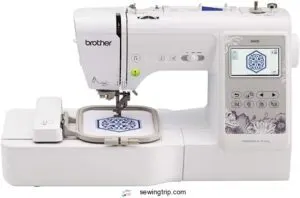
You’re exploring the Brother Sewing and Embroidery Machine, a great option.
It combines 103 built-in stitches with 80 embroidery designs, featuring a 4"x4" embroidery field.
This machine is suitable for beginners, offering a color touchscreen and automatic needle threader.
It’s easy to use, with a quiet operation and bright LED light, making it perfect for sewing and embroidery projects.
Best For: beginners who want a versatile machine for both sewing and embroidery projects with a user-friendly interface and quiet operation.
- Versatile for both sewing and embroidery
- Custom design import capability
- Automatic thread-pulling feature simplifies multi-color projects
- Bulky and space-consuming
- Limited embroidery field size
- Requires careful setup for embroidery functionality
7. Brother computerized sewing embroidery machine
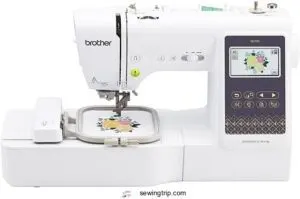
You’re examining the Brother computerized sewing embroidery machine.
This model combines sewing and embroidery capabilities, featuring a 5"x7" embroidery field and 193 built-in designs.
It offers wireless connectivity, automatic thread trimming, and a large color touchscreen for easy navigation.
With 241 stitch options, it’s suitable for various projects, making it a great choice for those seeking versatility in their embroidery machine.
Best For: beginners and experienced users who want a versatile machine that can handle both sewing and embroidery tasks with ease.
- Combines sewing and embroidery capabilities in one machine
- Features wireless LAN connectivity for easy file transfer from PC
- Offers a large color touchscreen for on-screen editing and navigation
- Some users reported connectivity issues with mobile apps
- Mixed reviews on customer service and warranty support
- Requires additional materials like thread, stabilizer, and scissors
8. Janome embroidery machine for sewing
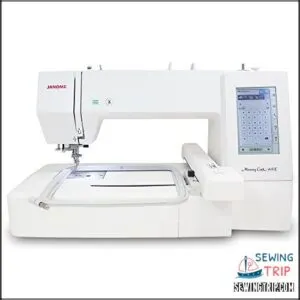
You’re checking out Janome embroidery machines for sewing.
They offer reliable models like the HD1000 with 14 built-in stitches and the M7200 with 200 utility stitches.
Janome machines are known for their user-friendly design and affordability, making them a great choice for sewers of all skill levels, from beginners to experienced embroiderers seeking quality results.
Best For: Janome embroidery machines are best for sewers of all skill levels, from beginners to experienced embroiderers seeking quality results.
- User-friendly design makes it easy to use for sewers of all skill levels
- Affordable price point compared to other embroidery machines on the market
- Reliable models with a range of built-in stitches and features
- Some users have reported issues with USB functionality and file compatibility
- Thread breakage problems can occur if not using the correct bobbin case
- Limited to.jef file format for USB imports, which may not be compatible with all design software
9. Commercial Embroidery Machine Smartstitch S1501
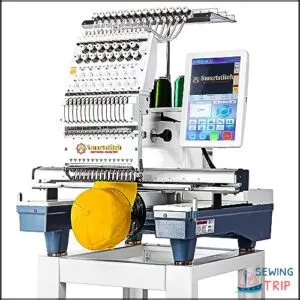
You’re considering the Smartstitch S1501, a 15-needle commercial embroidery machine.
It features a 14"x20" embroidery area and 1200 stitches per minute.
This machine is ideal for starting or expanding an embroidery business, offering professional results and excellent customer support.
Its advanced computer system and WiFi connectivity make it a great choice for those seeking high-quality embroidery capabilities.
Best For: beginners and experienced users looking to start or expand an embroidery business with industrial-level capabilities.
- Has a steep learning curve, especially for beginners
- Requires careful unpacking and retention of original packaging for potential returns
- Priced around USD 6,000, which may be expensive for some individuals or small businesses
- Offers professional results with its 15-needle capacity and 1200 stitches per minute
- Features a 12" touch screen, WiFi connectivity, and advanced computer system for streamlined workflow
- Provides excellent customer support and comprehensive training materials for easy learning
Embroidery Machine Features
You’re looking for the right computerized embroidery machine, and understanding its features is key.
You’ll want to evaluate factors like wireless connectivity, automatic thread trimming, and large embroidery fields to find the machine that best fits your needs.
Wireless Connectivity and Design Transfer
Modern computerized embroidery machines’ wireless connectivity transforms your creative workflow.
Wi-Fi embroidery eliminates cables, letting you send designs directly from computers, tablets, or phones. Design transfer happens instantly through dedicated embroidery machine apps like Artspira, while USB transfer remains available as backup.
Cloud storage integration enables seamless file sharing across devices. Wireless connectivity streamlines production, reducing manual transfers for efficient embroidery creation.
For ideal results, consider the best embroidery machines to enhance your project’s quality and overall design flexibility.
Automatic Thread Trimming and Tension
Modern embroidery machines’ automatic thread trimming and tension features eliminate manual intervention between colors.
You’ll appreciate how these systems prevent thread breakage while maintaining consistent stitch quality throughout complex designs.
- Automatic thread cutter – Precisely cuts jump stitches and color changes without fraying
- Thread tension adjustment – Automatically compensates for different thread weights and fabric types
- Thread management sensors – Detect breakage and pause operation to prevent design damage
- Embroidery tension monitoring – Continuously adjusts upper and bobbin thread balance
- Automatic cutting coordination – Times cuts with needle position for clean thread ends
Large Embroidery Fields and High-Speed Stitching
You’ll love computerized embroidery machines with large embroidery fields and high-speed stitching, perfect for quick designs.
Fast stitching and large hoops make them ideal for complex projects, offering wireless connectivity and multineedle capabilities for efficient embroidery.
Computerized Vs Regular Sewing
You’re considering a computerized embroidery machine, but you’re not sure how it differs from regular sewing.
Computerized machines offer advanced features like automatic thread trimming and wireless design transfer, which can enhance your sewing and embroidery experience.
Stitch Type and Function Differences
Moving from advanced features, let’s talk about what really sets computerized embroidery machines apart: stitch variations and function.
You get a buffet of embroidery machine stitch types—running, satin, and fill stitches—each designed for different embroidery techniques and fabric compatibility.
These machines handle complex patterns, offer precise needle control, and work with all sorts of thread types, thanks to digital embroidery modes and wireless connectivity.
| Feature | Computerized Embroidery Machines |
|---|---|
| Stitch Variations | Extensive, programmable |
| Needle Control | Automated, high precision |
Embroidery Capabilities and Limitations
You’ll quickly notice computerized embroidery machines shine with design complexity and precision, but they’re not magic wands.
Thread limits, stitch density, and hoop sizes all shape what you can create. Some fabrics, like leather, need special care, and super-fine details or subtle gradients can stump even the best machines.
Here’s a quick embroidery machine comparison:
| Capability | Limitation |
|---|---|
| Handles complex designs | Thread limits restrict color changes |
| Adjustable stitch density | Hoop sizes cap design area |
| Works on many fabric types | Struggles with tiny details |
So, while embroidery techniques keep evolving, every machine has its quirks—know your embroidery machine limitations before you stitch.
Sewing and Embroidery Combination Machines
Combo machines bring sewing, embroidery, and creative freedom into one clever box.
With a sewing and embroidery machine combo, you’re set for both fast seams and beautiful stitches.
Compare Sewing Speed, Embroidery Field, and Thread Tension with this table:
| Machine Comparison | Sewing Speed | Embroidery Field |
|---|---|---|
| Brother SE700 | 710 spm | 4” x 4” |
| Brother SE2000 | 850 spm | 5” x 7” |
| Janome MC400E | 860 spm | 7.9” x 7.9” |
Starting Embroidery Business
You’re considering starting an embroidery business, and you want to know if it’s profitable.
You’ll need to calculate your initial investment, ongoing costs, and develop marketing and sales strategies to succeed in the embroidery services industry.
This involves understanding the embroidery services industry and how to position your business for success.
Is an Embroidery Business Profitable
Embroidery businesses can be profitable, with an average profit margin of 15-20%. Home-based setups often yield higher margins due to lower overhead costs. Hand embroidery can reach an 80% net margin.
Profitability depends on factors like efficient production, competitive pricing, and niche targeting.
- Fashion accessories and luxury leather goods offer high profits.
- Custom designs and personalized products boost margins.
- Caps and hats generate significant hourly profits.
Initial Investment and Ongoing Costs
Starting an embroidery business requires considering initial investment and ongoing costs.
Machine costs range from $200 to $30,000.
You’ll also face operating fees, maintenance expenses, and supply prices, affecting the embroidery machine’s cost-effectiveness and budget planning, including potential upgrade costs.
Marketing and Sales Strategies for Embroidery Services
You’ll need to develop marketing and sales strategies for your embroidery services.
Conduct market research to identify your target audience and create effective branding tips, sales tactics, and pricing strategies to engage customers and grow your online embroidery machine business.
Selecting Best Embroidery Machine
You’re looking for the best embroidery machine, and it’s vital to take your needs and skill level into account.
You’ll want to choose a machine that fits your budget, has the right features, and is easy to use, so you can create beautiful embroidery designs with ease.
Purpose and Skill Level Considerations
You’re evaluating computerized embroidery machines, considering your purpose and skill level.
As a beginner, look for user-friendly machines with beginner tips and capabilities that match your needs, ensuring a smooth user experience and proper machine selection based on your embroidery machine skill level.
When selecting a machine, understanding the importance of embroidery machine basics is essential for making an informed decision, and it helps to find machines that provide a smooth user experience.
Design Software and Editing Capabilities
When selecting computerized embroidery machines, consider design software and editing capabilities.
Key features include:
- Design Tools
- Editing Features
- Custom Fonts
- Digitizing Software, for easy embroidery machine design transfer and editing options.
The quality of embroidery design software is essential for creating intricate embroidery design patterns, which can be enhanced with the right editing capabilities.
Machine Durability and Customer Support
When investing thousands in embroidery equipment, you’ll want rock-solid machine reliability and stellar customer support.
Check warranty options carefully—some manufacturers offer extended coverage while others provide basic one-year protection.
Research repair costs upfront, as specialized embroidery machine maintenance can get pricey.
Quality support teams make troubleshooting smoother when you’re racing deadlines.
Advanced Embroidery Techniques
You’ve mastered basic computerized embroidery, but advanced techniques reveal your machine’s full potential.
Professional-level features like design editing software, specialty stitching methods, and systematic troubleshooting transform simple projects into stunning masterpieces, utilizing specialty stitching methods to create unique effects.
Using Design Software for Custom Embroidery
Design software transforms your computerized embroidery machines into creative powerhouses.
You’ll master embroidery digitizing through specialized programs that convert artwork into precise digital stitching patterns.
Modern embroidery machine software offers powerful design editing capabilities alongside extensive custom fonts libraries.
Here’s what you’ll accomplish with professional digitizing tools:
- Auto-digitize logos – Convert JPEGs into embroidery designs using built-in conversion algorithms
- Customize thread colors – Match exact brand specifications through detailed color palettes
- Create monograms – Design personalized text using hundreds of built-in and downloadable fonts
Popular embroidery apps like PE Design Plus connect seamlessly with your machine, while free options like Inkscape handle basic DST file creation for budget-conscious crafters.
When selecting software, consider the importance of having best embroidery software to guarantee superior results and ease of use.
Advanced Stitching and Embellishment Techniques
Once you’ve mastered custom design creation, you’ll want to explore advanced stitching techniques that transform basic embroidery into professional artwork.
Computerized embroidery machines excel at layered stitching, where you combine different stitch types for texture and depth.
Try using satin stitches for bold outlines, then fill areas with cross-hatching patterns.
Thread management becomes critical here—darker threads underneath lighter ones create shadows, while metallic threads add shimmer when placed strategically.
Your automatic needle threader saves time during frequent thread changes.
Experiment with fabric selection too, as different materials interact uniquely with various stitch densities and embellishment tools.
Troubleshooting Common Embroidery Machine Issues
Thread breakage happens when tension settings don’t match your thread weight or fabric.
Machine jamming often stems from lint buildup or incorrect threading.
Needle issues include bent tips from hitting hoops or wrong needle sizes for thread types.
Hoop problems occur when fabric isn’t taut enough, causing puckering.
Bobbin trouble usually means improper winding or wrong bobbin type.
Most embroidery machine troubleshooting starts with cleaning and re-threading your computerized embroidery machine.
Frequently Asked Questions (FAQs)
What is the difference in embroidery machines?
Machine manufacturers make embroidery equipment with varying hoop sizes, built-in designs, connectivity options, and stitching speeds.
You’ll find entry-level models offer 4"x4" fields while professional machines provide 20"x14" areas, determining your project possibilities and creative potential.
What is the difference between Brother and Babylock embroidery machines?
You’ll notice Brother machines typically offer larger built-in design libraries and better wireless connectivity, while Babylock focuses on premium build quality and advanced tension systems for professional results.
What is the difference between Brother SE and PE?
You’ll find SE models combine sewing and embroidery functions, while PE machines focus exclusively on embroidery.
SE machines include built-in stitches for regular sewing projects, making them versatile for crafters who want both capabilities in one machine, with sewing and embroidery being key features.
What is the best computerized sewing machine to buy?
You’ll want either Brother SE700 or SE2000 for versatility—they combine sewing and embroidery seamlessly. Both offer wireless connectivity, built-in designs, and user-friendly touchscreens that’ll simplify your creative projects.
What file formats do embroidery machines support?
You’ll find most embroidery machines support.PES, .DST, .PHC, and.PEN formats.
Brother machines typically use .PES files, while commercial machines often accept.DST.
Always check your machine’s manual for compatibility.
How much memory storage do machines typically have?
Like treasure chests holding precious gems, embroidery machines store digital designs in their memory banks.
You’ll find basic models with minimal storage, while advanced machines like Brother’s offer 3MB memory for importing countless patterns and custom creations.
Can machines embroider on thick materials like leather?
Most machines can handle leather, but you’ll need heavy-duty needles, slower speeds, and proper stabilizers. Check your machine’s specifications for maximum fabric thickness—typically around 6mm for home machines.
What maintenance schedule do embroidery machines require?
Your Brother PE900 needs oil every 8-10 hours of stitching, like changing your car’s oil regularly. Clean lint weekly, replace needles after 8 hours, and service annually for peak performance.
Do machines work with third-party design software?
You can usually import designs from third-party embroidery software, as most machines support common file formats like.pes or.dst.
Just use a USB drive or Wi-Fi, and you’ll stitch out custom creations with ease.
Conclusion
Ironically, choosing between computerized embroidery machines compared to regular models isn’t as tricky as threading a needle on the first try.
When you weigh the high-tech features, such as wireless design transfers and automatic thread trimming, you’ll soon realize these machines do most of the heavy lifting.
Focus on what matters for your projects—embroidery field size, functions, and built-in designs—then match the right model to your creative needs.
Just don’t blame the machine when inspiration strikes at 2 a.m.
- https://www.gminsights.com/industry-analysis/computerized-sewing-and-embroidery-machine-market
- https://www.archivemarketresearch.com/reports/computerized-home-embroidery-machines-444892
- https://machine.goldsupplier.com/blog/embroidery-machines-computerized/
- https://www.maggieframes.com/blogs/embroidery-blogs/automatic-embroidery-machine-features-comparisons-and-buying-tips
- https://insights.made-in-china.com/What-Is-a-Computerized-Embroidery-Machine-Exploring-Features-User-Needs-and-Design-Considerations_kTaGUJZOVQDP.html

